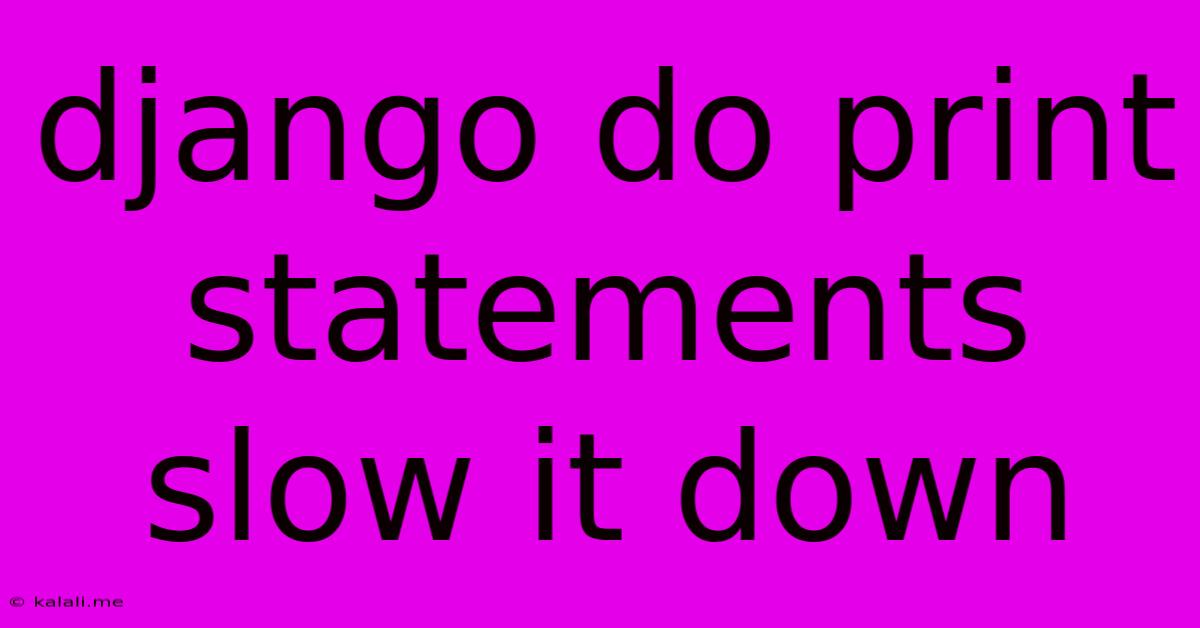Django Do Print Statements Slow It Down
Kalali
Jun 05, 2025 · 3 min read

Table of Contents
Does Using Print Statements in Django Slow Down Your Application?
This article delves into the impact of print statements on Django application performance, exploring why they can cause slowdowns, and offering practical strategies to mitigate these performance issues during development and deployment. Debugging your Django application efficiently is crucial, and understanding how seemingly simple actions like using print statements can affect performance is a key aspect of that process.
The Problem with Print Statements in Production
While print statements are invaluable for debugging during the development phase, they represent a significant performance bottleneck in production environments. This is because every time a print statement executes, the application has to:
- Format the output: The
printfunction needs to convert variables and data structures into a human-readable string representation. This process, though seemingly trivial, consumes processing power, especially when dealing with complex data. - Write to standard output (stdout): The formatted output then needs to be written to the standard output stream. This involves system calls, which are relatively expensive operations compared to other in-memory computations. In a high-traffic environment, these calls can accumulate, significantly impacting response times.
- I/O operations: Writing to stdout often involves I/O operations, which are inherently slower than in-memory calculations. This is particularly true if your application is running in a containerized environment or on a remote server.
- Blocking operations: The
printoperation can be a blocking operation, meaning it pauses the execution of your code until the output is written. This can lead to noticeable delays, especially in real-time or performance-sensitive applications.
Why Print Statements Matter More in Django
Django applications often handle a large volume of requests concurrently. Each print statement within a request-handling view or middleware contributes to the overall slowdown. This effect is compounded in high-traffic scenarios, leading to noticeable delays and potentially impacting the user experience. The overhead becomes proportionally larger as the number of requests and the frequency of print statements increase.
Strategies for Efficient Debugging in Django
Fortunately, there are numerous alternatives to print statements that offer far superior performance during development and allow for efficient debugging without sacrificing application speed:
1. Logging
Django's built-in logging system provides a powerful and efficient way to handle debugging messages. Logging messages can be directed to files, the console, or even remote logging services. This allows you to easily control the level of detail and the destination of your debug messages without impacting production performance.
- Example:
logging.info("This is an informative message.")
2. Debugging Tools and IDEs
Modern IDEs like PyCharm and VS Code provide powerful debugging tools, allowing you to step through your code, inspect variables, and set breakpoints without relying on print statements. These tools offer a much more efficient and controlled debugging experience.
3. Conditional Logging
Instead of printing continuously, use conditional logging statements to output messages only when specific conditions are met. This prevents unnecessary overhead by limiting logging only to relevant situations.
- Example:
if some_condition: logging.debug("Condition met!")
4. Using a Debug Toolbar
Django debug toolbars provide valuable insights into application performance, including database queries, template rendering times, and caching information. These tools are invaluable for identifying performance bottlenecks without resorting to intrusive print statements.
5. Temporary Logging for Specific Issues
For targeted debugging, add temporary logging statements to pinpoint specific issues, then remove them once the problem is resolved. This is a more controlled approach than leaving numerous print statements scattered throughout the codebase.
Conclusion
While print statements are convenient for quick checks during development, their overuse in Django applications can significantly impact performance, especially in production. By adopting the strategies outlined above—leveraging Django's logging system, utilizing IDE debugging tools, and employing conditional logging—developers can significantly improve the performance and scalability of their Django applications while maintaining a robust debugging workflow. Remember, efficient debugging practices are crucial for building robust and performant web applications.
Latest Posts
Latest Posts
-
Dnd Death Ward How Long Does It Last
Jun 07, 2025
-
Does Greyhound Accept Prison Id Bracelets In Virginia
Jun 07, 2025
-
Why Did Eren Fight Alongside Zeke
Jun 07, 2025
-
How To Send Prompt To Chatgpt With A Query String
Jun 07, 2025
-
How To Find A Key Fob
Jun 07, 2025
Related Post
Thank you for visiting our website which covers about Django Do Print Statements Slow It Down . We hope the information provided has been useful to you. Feel free to contact us if you have any questions or need further assistance. See you next time and don't miss to bookmark.